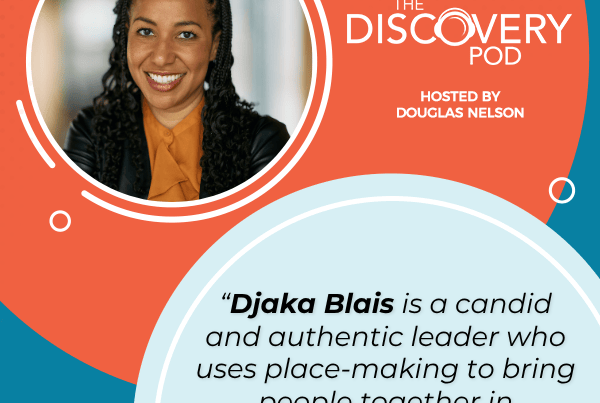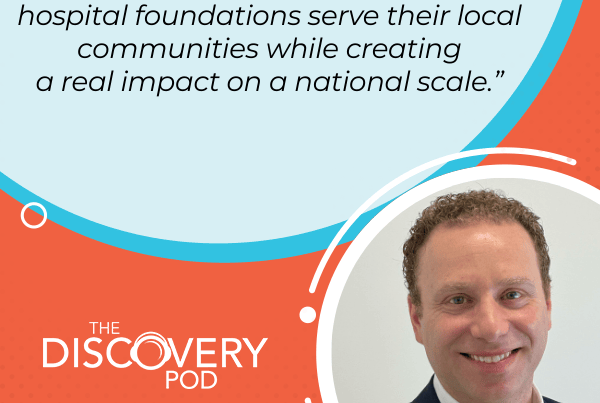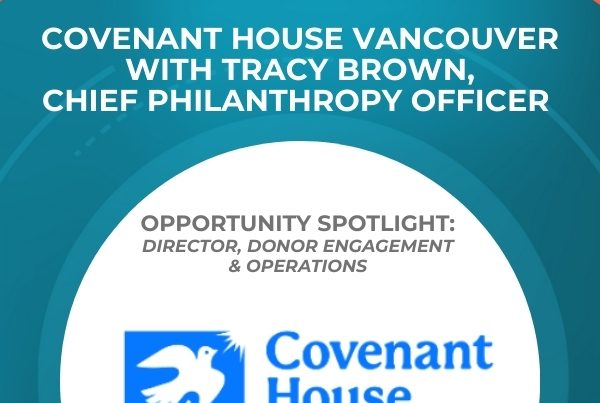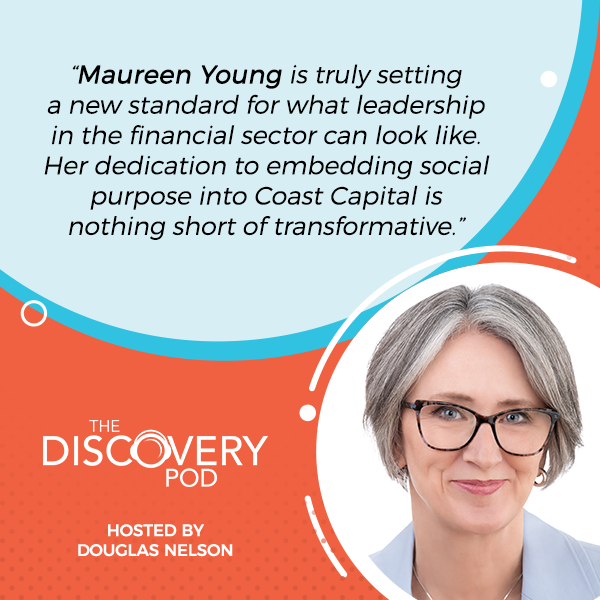
Today, we welcome Maureen Young, Vice President of Social Purpose at Coast Capital savings, to discuss the evolution of social purpose in business. Coast Capital savings has integrated social impact into its core business model, shifting away from traditional corporate responsibility. Maureen shares insights on how this approach fosters deeper community partnerships and drives meaningful change. Tune in to hear how Coast Capital is setting a new standard in the financial sector by embedding purpose into everything they do, and what this shift means for the future of business.
—
Listen to the podcast here
Coast Capital Savings With Maureen Young, Vice President, Social Purpose
I’m really excited to share this conversation I had with Maureen Young. Maureen is the VP of Social Purpose at Coast Capital Savings. Coast Capital Savings is an organization that has embedded social purpose at the core of its business model. I was really looking forward to the chance to learn from Maureen what that looks like within the organization, but most importantly, what it means for those organizations that are receiving funding and collaborating with Coast Capital Savings.
In our conversation, she talks about leading with a question, maintaining that sense of curiosity as you’re uncovering, renewing, and rebuilding the purpose of your own organization and what you need to do to be effective when approaching funders. Maureen talks about changes she’s seen in the sector and the evolutions that are to come. Her answer to the magic question of what you are looking forward to is one of my favorites in a long time. Please enjoy my conversation with Maureen Young.
—
Welcome to the show, Maureen.
Thank you. I’m so glad to be here, Doug.
Maureen, this is going to be an excellent conversation whenever we have someone who is on the funding side of the ledger in our sector. The readers go up, the feedback goes up, and your ratings bonanza. Even more importantly, I’m curious to hear and really, really looking forward to sharing the great work that you and your colleagues at Coast Capital do to invest in our social profit sector. Maybe you could start by telling us a little bit about Coast Capital’s approach.
First, just to level set a bit on Coast Capital, we’re a credit union. We’re a BC-based credit union that, a few years ago, actually became federally regulated. We’re now a federal financial cooperative and we serve about 600,000 members and we’ve got just under 2,000 staff and really working hard to create a new and exciting chapter for Coast and for our communities. In the last few years, we have made the decision to adopt a social-purpose business model.
That’s really integral when we think about how we’re partnering with the community because that shift has been a shift from a traditional corporate social responsibility approach, where you’ve got your social good programs on the side of the company, and you have your business doing its thing on the other side, to really trying to integrate and embed the social impact that you’re trying to achieve right into your business model into your products and services, your policies, your practices.
For us, that shift to social purpose has provided some real focus for us in terms of how we partner with the community and the types of things that we’re partnering with within the community. It’s also been a real shift in the way those relationships work from being us cutting a check. Our partner doing some good things to a more reciprocal arrangement where we’re really like the learnings are going back and forth, and the engagement is much more robust.
The Role Of Social Purpose In Business
I would imagine that your role as VP of social purpose is different than in a conventional financial institution, where the person responsible for that community engagement or the giving part of it is sidelined around the executive table. What is it like being right there at the core of the business?
First of all, there aren’t very many executives with the title social purpose. It is a really emerging field of practice. Certainly, when I headed our corporate social responsibility department, I was not on the executive team. Again, we actually signaled that shift to the organization by dismantling our corporate social responsibility department. We disbanded it. We established the social purpose office and created all new roles for the team.
Of course, we’re still doing the philanthropy, the sustainability initiatives, the climate stuff, the B Corp things, etc. We’re also now positioned as business partners in the other areas of the business so that we can support them in embedding our purpose into what they’re doing. That is when you really achieve that integration. It does require an executive presence for sure. Certainly.
How have the conversations with your colleagues changed as you’ve gone through that transition?
It’s early days. I’m just looking at the calendar there. It’s been a few years since we formally adopted the purpose. I should tell you what our purpose is. Our purpose is to unlock financial opportunities and grow incomes so that people can thrive together and we can build a better future. There were some very natural partners for us in those early days around the executive table. For example, our human resources area. We obviously want to live that purpose for our employees.
Our HR department was an incredible natural partner. What are we doing to support our employees by unlocking financial opportunities and growing their incomes through pay and benefits, flexible work arrangements, supported career development, and all those good things? In our products and services area, we like looking at how we can embed purpose into our offerings for our members. Those conversations have been fantastic. I think it’s been very energizing and galvanizing.
Now, we’re starting to look at the enabling functions of purpose. I don’t know, technology, for example. For them, it might be a little harder to make that leap. What’s my role in the purpose? Of course, they’re critical for us to be able to deliver it because they provide all of those. The infrastructure and the systems that make it possible. It’s been interesting. It’s been a learning experience. It’s been sometimes challenging, but other times so easy because when you can all of a sudden put all the dots together, there’s this sense of alignment, which is fantastic.

Coast Capital Savings: When you can align your business purpose with social impact, the sense of alignment is fantastic—it’s energizing and galvanizing.
From your perspective, how would an organization that you’re making donations to and working in collaboration with experience Coast Capital differently now than they would have years ago?
I would say that we had a more traditional model, for sure. Coast Capital has been extraordinarily community-minded. I should say that it’s not, we weren’t. That has always been a huge strength for Coastal Capital. We invest 10% of our budgeted bottom line every year back into the communities we serve. That’s a tremendous commitment. We did tend to have a bit of a peanut butter approach, maybe. We certainly had some focus areas, but it’s probably smaller relationships and smaller funding amounts to all kinds of different groups.
We would write a check. We would ask them to let us know the impact of that, of course, and to acknowledge post-capital. The difference today would be thinking about how we can align on a mutual area of interest. We’re very proactive rather than responsive. It was a responsive grant-making program before. Now, we’re talking to organizations that we know are doing good work that is aligned with our purpose and we’re asking them questions.
What are the gaps that you’re seeing? Where are you not getting support? Where do you think there was some targeted intervention? We could actually change the trajectory of a group of people, particularly people who face more barriers than others when moving up the income ladder. Surfacing an idea, surfacing an opportunity, co-creating that.
Of course, we’ll provide funding, but they’re also providing back to us, learning how we could not only serve that participant through a grant but also how we could do a better job of meeting the needs if they were members. For example, their financial services, etc. Thinking about what learning may be back to our HR department to help us bring some of those perspectives into our hiring processes. It’s a much more mutually engaging exercise than before.
We’re not just funders. We’re partners, working together to create real change in the community. Collaboration goes both ways. Share on XIt’s really encouraging to hear that evolution is taking place in our sector. I think from the work we get to do here at the Discovery Group with clients, those clients that we have had the opportunity to work with Coast Capital rave about the work they get to do. Of course, the funding but they start with funding and move quickly to the conversation that you just described. I think that is clearly a two-way street.
Maureen Young’s Journey Into The Social Profit Sector
I want to pivot a little bit to your background, Maureen, because I said as we were getting started and setting up for the show that you have the job that most fundraisers about 2 or 3 years into their career say, “This is great.” I love working for an organization that raises money and does all this great work in the community, but wouldn’t it be great to one day be the one who gives it away? I think people probably have elevated ideas about what that looks like and how hard it is to give money away. How did you get started in our social profit sector? Tell us a little bit about your journey.
It was a winding journey. I started off as a junior research consultant in a larger consulting firm. As part of that effort, I was sent up into the interior of BC, into the Kootenays, to do some fieldwork. The project was basically looking at how the Kootenay region, East and West, could better engage or create some economic development activity around their tourism sector, but do it in a thoughtful community-based way that would share their unique, amazing heritage, etc., and their values. I went up there for ten days and it changed my life. I ended up bidding on the opportunity to head up the new nonprofit that was going to be established to implement strategy and weirdly got it. I was only 25. Two weeks later, I had to move to Nelson, BC.
That sounds like an I’m 25 story.
It was great. I remember I went to get a loan for a desktop computer. I didn’t have one of those. I didn’t even have a car. I borrowed a car from my parents and I moved up there. It was just a big adventure. I stayed up there for ten years. I had an incredible experience there. I was part of that amazing community-based work. The province funded it, but it was working with nonprofits all around the Kootenay region, as well as some of the private sector to really think about how to build economic development activity in a values-based way in that community.
I then became the economic development officer for the Nelson and District area. Again, very amazing community looking for the same thing, but broader than tourism. Looking to build an economy there following some difficult years through the ‘80s and early ‘90s as the resource sector was struggling. An amazing opportunity. I went to work for the Fraser Basin Council. I moved back down to the coast and that organization is something else. Looking at how to advance the Fraser River Basin’s economic, environmental, and social sustainability from the height of land up at Prince George or at the headwaters right down to the mouth of the Fraser and then up on either side of the mountains there.
An enormous area. Again, incredibly exciting, wonderful work. I loved it very much. I had the opportunity to work for Coast Capital to help build their community economic development programs. I thought, “How unique is that? That a financial institution would have an area called economic development.” I joined Coast and that was many years ago. Exciting, I’d spent a lot of time in the nonprofit sector, helping to raise the dollars to do the projects that were going to make a difference. To your point, it was pretty intriguing to move to the other side of the table.
Learning To Collaborate In Corporate Life
What do you remember about that transition and realizing, “This is very different?”
I remember thinking that so many of the skills that I had were transferable. I had a lot to learn about corporate life, for sure. The best was the moment I had an IT problem and there was actually an IT department to call. I had a lot to learn about corporate life, but I had the community building, the relationship building. Much of the work is grounded in partnership, understanding how to collaborate, knowing how to surface areas of need and considering potential solutions, and putting the partnership together.
I would say that even my time as a junior research consultant, I felt how can I be a junior research consultant when I’ve never had any life experience. How can I be consulting others or providing consultant support to others? A wise senior researcher told me, “You don’t have to have all the answers, but you need to know where to look, how to find the answers, and how to surface the opportunities. That’s the skill.” That skill has really served me all the way along.
Good questions are often more valuable than an immediate answer. You have a unique perspective on our social profit sector. You get to see the very best, the most innovative, the dynamic, and then maybe some organizations that are a step or two behind that. I’m curious what your perspective is on what makes an organization successful in pursuit of its own purpose and in partnership with Coast Capital.
Good questions are often more valuable than immediate answers. It's about understanding the need and collaborating on solutions. Share on XWhen I think about some of the superstars out there, I would say they’re tremendous communicators and that is huge. When you’re working in an ecosystem-type environment, there has to be this ongoing relationship, and exchange of information that’s very dynamic. Again, it’s that shift from leaving us to our knitting and we’ll let when we need funding or we’ll let when we’ve got the final report to share. Really strong communication, focused. It’s easy to get off your mission. You need to know what your purpose is as an organization.

Coast Capital Savings: What makes an organization successful? Clear communication, knowing your purpose, and leveraging partnerships to achieve shared goals.
That’s certainly been the journey that Coast Capital has been on. Define why your organization exists. Why does it exist? Really thoughtfully put together the core programs that are going to help you execute that purpose. Probably last, look for other organizations that have intersecting interests where you can actually leverage that shared set of objectives to do something in collaboration. I think the days of going it alone are over.
Success comes from strong communication and partnerships. You can’t go it alone anymore in today’s world. Share on XImportance Of Collaboration In The Social Sector
You said that like it was a question, but I think it’s pretty definitively a statement that collaboration is really an essential part of the work. What are those elements of collaboration? I’m sure at Coast Capital, you’re willing to be one end of that one part of that collaboration of that partnership. It’s often for big issues like housing or any of the major social issues that we’re facing now. It often is multiple organizations coming together in a collaboration. What have you seen that is particularly effective in supporting those collaborations to form?
I would say it’s something we’ve talked about before, Doug, and that is maybe putting the ego aside. I think organizations need to set the table for collaboration by really being grounded in those initial days. Let’s focus on the change we want to see. Let’s be open to bringing forward the opportunities, the ideas, and the thoughts around how we could actually work together in a meaningful way. When I think about some of the conversations underway now, those organizations who really show up with curiosity, not just to share, here’s what we’re doing. Do you want to come and join what we’re doing?
Here’s a problem that we think needs some attention. Here are some of the things we know or understand about that problem, and here are some things we think we could bring to the table. What about you? What do you see? What from your side? What perspectives do you have? What skills and experience do you have? Is there something we could do together that would allow us to have that openness and willingness to collaborate as equal partners?
Once again, you’re coming back to start with a question and not a preconceived answer. I don’t want to dwell too much on this because we try to focus on the abundance in our sector at the show. Not every organization is currently experiencing abundance and often, we see some organizations getting in their own way in terms of being able to pursue their purpose or even define what their purpose might be. What advice would you have for a leader of an organization if they recognize they’re not quite clicking? They don’t have it quite right? How can they get back on the good foot and move their organization forward?
I think it’s important for all of us to reach out to our various stakeholders. Invite feedback and input into the role of the organization, how the organization is executing or not executing, and seek that advice or feedback on how to potentially improve, adjust, or realign. Some of these organizations have been around for a long time.
It’s easy for the purpose of the organization, but maybe that is not as relevant nowadays as it needs to be. Again, rather than saying, “Here’s what we need to do, you probably need to get there eventually, but just start with some curiosity, go and seek the feedback and make that a safe experience for your stakeholders to engage in, whether it’s your employees or the people that you’re serving or the funders that you’re working with, etc.
It reminds me of an organization I was speaking to some months ago, and the advisor gave me, “What are your essential partners? How do you show up as essential in their life and in their work?” The response came from a board member. If we ask them, they’ll just want us to do more of what we’re already doing. We believe we can do so much more.
For who?
They were caught between what they saw as a grand ambition for the organization and its purpose beyond the expectations or even the hopes of those essential partners they were working with. Their ambition didn’t match the expectations of their funders or of those that they were serving. They had a real crossroads that they had to come to change who they were serving, change who was funding them, go back to basics, and do a really good job of doing what people wanted them to do, who needed them to be doing.
That’s the value proposition. I think every organization needs to understand what is the value proposition that their stakeholders need and how they can deliver on that. Be open to the answer to that question.
Facing Challenges In The Social Profit Sector
We talked about the transition at Coast Capital. We talked about your transition. This social purpose or social profit sector that we both work in and around has been transitioning quite a bit as well. I think mostly for the better and actually definitely for the better. What are the trends and changes that you’re seeing most often in your work at Coast Capital?
Say that we’re obviously, unfortunately, seeing some really heightened challenges in our communities, whether it’s poverty or addiction or mental health or inequality or into climate, biodiversity loss, etc. There’s an urgency that is definitely on people’s minds. I think we’ve talked around these issues for many years and they’re really becoming fairly significant and impacting everyday life for most people.
That is terrible. It also potentially provides some sense of a renewed focus. It can be galvanizing and help you have different relationships with your stakeholders. I think that has definitely been a big focus for sure. Seeing the organizations who can see the unique role they can bring to solving some of those problems and getting innovative and creative around it. They’re the ones who are winning, I would say.
My eyes are wide open, I ask good questions, and I engage in the issues that matter most. Maureen, if you had a magic wand, you just got to. It’s a one-use, single-use magic wand. We’ll say it’s not made of plastic because you mentioned the climate issues. Single-use magic wand. What is one thing you would change about the social profit sector? It can be either the sector in general or one thing that happens within organizations in the sector.
The Need For Organizational Partnerships
What a good question. I wonder if we have a lot of social profit organizations, and if some teamed up and really leveraged their various skill sets and capabilities, and whether we couldn’t do more.
You must see it as it comes through your desk, your email inbox, or those of your colleagues in very similar organizations serving a very similar population on a similar cause, but they’re different organizations. Then you’re left as a funder going, which one, A or B, makes the most sense? Maybe the combined entity would be more successful.
We have oftentimes been matchmakers in those moments because they may not even know about each other or not be aware of the different initiatives that are underway in their own community. A long time ago. I started a program called, it was called Helping the Helper. It was a nonprofit leadership opportunity for this community here in Victoria. It was like a five-part series and I think I had started it because I had seen, that we would bring in, for example, at Coast Capital, like a leading expert on board governance who would come in and teach us how to really operate effectively.
I thought, “Wouldn’t it be great if we could make some of this expertise available to the nonprofit sector?” We ran it for about seven years. We had about 3,500 participants over that time. We charged $75, enough that people would come because it’s free. Sometimes it changed their mind on the day of, but it always surprised me. The learning, of course, during the sessions was that each session was about a different thing.
It could be around finance, marketing, HR, or whatever, but what was so fascinating was the coffee breaks and the lunch hours because people talk, “Tell me what you’re doing again.” There’s not a lot of time for that. There’s not always the space created for it, but those moments to connect, share, and find out, “I should work with you.” Human connection is really at the heart of the sector at large.
The more opportunities you do, the stronger the sector is going to be. Maureen, as we come to the end of our conversation, I get to ask my favorite question. Maureen, what are you looking forward to?
This last chapter of my career, embedding social purpose into every aspect of the enterprise, and then you cannot actually achieve a societal ambition on your own. By its very nature, it’s way bigger than you. You must collaborate in the ecosystem. We have just started to create some unique and interesting partnerships. I am looking forward to executing those and surfacing new opportunities. Even bigger than that, encouraging more companies to join the social purpose movement. I think this is where business needs to go. Business can be an engine for good, and I’m excited to see more businesses take that journey.
You can't achieve societal ambition on your own. By its nature, it's bigger than you. Collaboration is key in the social purpose ecosystem. Share on XI’m excited to see how you do that and appreciate the work you and your colleagues at Coast Capital have done to set a new standard for how financial institutions can partner with the social profit sector. It’s been great to have you on the show. Thank you so much for sharing your perspective and your wisdom.
Thanks for having me, Doug. It’s been a great conversation.
Important Links
- Maureen Young – LinkedIn
- Coast Capital Savings
About Maureen Young
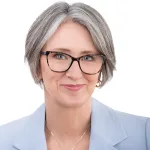 Leads the development and implementation of Coast Capital’s long-term social purpose impact plan and the integration of social purpose across company operations, recognized with a 2024 Benevity Moonshot Award for its innovative and bold approach to corporate purpose. Oversees Coast Capital’s sustainability initiatives, including its net zero commitments, B Corp certification, and leads Coast Capital’s community investment program, which sees 10% of Coast Capital’s budgeted bottom line reinvested into the community.
Leads the development and implementation of Coast Capital’s long-term social purpose impact plan and the integration of social purpose across company operations, recognized with a 2024 Benevity Moonshot Award for its innovative and bold approach to corporate purpose. Oversees Coast Capital’s sustainability initiatives, including its net zero commitments, B Corp certification, and leads Coast Capital’s community investment program, which sees 10% of Coast Capital’s budgeted bottom line reinvested into the community.
Member and co-founder of the Canadian Purpose Economy Project which seeks to accelerate the transition to the purpose economy. Past Chair and co-founder of the Youth Futures Education Fund, focused on ensuring youth from the foster care system can achieve their post-secondary education. Board member of the BC Co-op Association and the Victoria Forum, a partnership with the University of Victoria and the Canadian Senate. 2024 recipient of the Gary Gillam Award, which celebrates individuals within the BC and Ontario credit union systems who have demonstrated cooperative values and made significant achievements in social impact.

